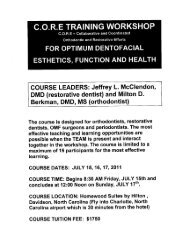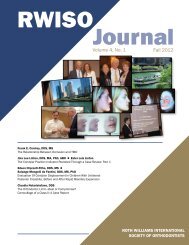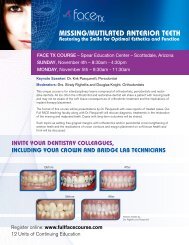2010 RWISO Journal - Roth Williams International Society of ...
2010 RWISO Journal - Roth Williams International Society of ...
2010 RWISO Journal - Roth Williams International Society of ...
Create successful ePaper yourself
Turn your PDF publications into a flip-book with our unique Google optimized e-Paper software.
the .05 level <strong>of</strong> significance in the right horizontal, right ver-<br />
tical, and left vertical planes. Furthermore, the MI-CR pattern<br />
is observed, suggesting that this is not a purely random<br />
phenomenon. Since the control group was small, there is the<br />
possibility <strong>of</strong> an underpowered study.<br />
In the transverse plane, there appears to be no difference<br />
between the 2 groups over time. A condylar axis distraction<br />
in the transverse plane is more sensitive to clinical problems<br />
than a condylar axis distraction in the horizontal and vertical<br />
planes. 17,18,19 It appears that gnathologic positioners improve<br />
the result <strong>of</strong> orthodontic treatment with respect to condylar<br />
axis distraction.<br />
Conclusion<br />
Results <strong>of</strong> the present study indicate a statistically significant<br />
improvement in MI-CR discrepancy in the right horizontal,<br />
right vertical, left vertical, and transverse planes with 2<br />
months <strong>of</strong> gnathologic positioner wear. The amount <strong>of</strong> condylar<br />
distraction in these 4 measurements showed statistically<br />
significant improvement and came within the envelope<br />
<strong>of</strong> susceptibility. The positioner and control groups tend to<br />
change differently over time in the vertical and horizontal<br />
planes, with the positioner group improving and the control<br />
group getting worse. In the transverse plane, gnathologic positioners<br />
improve the result <strong>of</strong> orthodontic treatment with<br />
respect to condylar axis distraction. ■<br />
References<br />
1. Okeson JP. Management <strong>of</strong> Temporomandibular Disorders and Occlusion.<br />
3rd ed. St Louis, MO: Mosby; 1998:109-125.<br />
2. Schmitt ME, Kulbersh R, Freeland T, et al. Reproducibility <strong>of</strong> the<br />
<strong>Roth</strong> power centric in determining centric relation. Semin in Orthod.<br />
2003;9(2):102-108.<br />
3. Andrews LF. The six keys to normal occlusion. Am J Orthod.<br />
1972;(62):196-309.<br />
4. Stuart CE. Good occlusion for natural teeth. J Prosthet Dent.<br />
1964;(14):716-724.<br />
5. <strong>Roth</strong> RH. Temporomandibular pain dysfunction and occlusal relationships.<br />
Angle Orthod. 1973;(43):136-153.<br />
6. <strong>Roth</strong> RH. Treatment mechanics for the straight wire appliance. In:<br />
Graber TM, Swain BH, eds. Orthodontics: Current Principles and<br />
Techniques. St Louis, MO: Mosby; 1985:665-716.<br />
7. <strong>Roth</strong> RH. Occlusion and condylar position. Am J Orthod Dent<strong>of</strong>ac<br />
Orthop. 1995;(107):315-318.<br />
8. Pangrazio-Kulbersh V, Poggio V, Kulbersh R, et al. Condylar distraction<br />
effects <strong>of</strong> two-phase functional appliance/edgewise therapy versus<br />
one-phase Gnathologically based edgewise therapy. Semin in Orthod.<br />
2003;9(2):128-139.<br />
9. <strong>Roth</strong>, RH. The maintenance system and occlusal dynamics. Dent<br />
Clin North AM 1976;20:761-788<br />
10. Arnett GW, Milam SB, Gottesman L. Progressive mandibular<br />
retrusion-idiopathic condylar resorption, part II. Am J Orthod.<br />
1996;(110):117-127.<br />
11. <strong>Roth</strong> RH. Functional occlusion for the orthodontist, part I. J Clin<br />
Orthod. 1981;(15):32-51.<br />
12. Crawford SD. Condylar axis position, as determined by the occlusion<br />
and measured by the CPI instrument, and signs and symptoms <strong>of</strong><br />
temporomandibular dysfunction. Angle Orthod. 1999;(69):103-116.<br />
13. Utt TW, Meyers CE Jr, Wierzba TF, Hondrum SO. A three-dimensional<br />
comparison <strong>of</strong> condylar position changes between centric relation<br />
and centric occlusion using the mandibular position indicator. Am<br />
J Orthod Dent<strong>of</strong>ac Orthop. 1995;(107):298-308.<br />
14. Slavicek R. Interviews on clinical and instrumental functional<br />
analysis for diagnosis and treatment planning, part I. J Clin Orthod.<br />
1988;(22):358-370.<br />
15. Lavine D, Kulbersh R, Bonner P, Pink FE. Reproducibility <strong>of</strong> the<br />
condylar position indicator. Semin in Orthod. 2003;9(2):96-101.<br />
16. Klar NA, Kulbersh R, Freeland T, et al. Maximum intercuspationcentric<br />
relation disharmony in 200 consecutively finished cases in a<br />
gnathologically oriented practice. Semin in Orthod. 2003;9(2):109-<br />
116.<br />
17. Kulbersh R, Dhutia M, Navarro M, et al. Condylar distraction<br />
effects <strong>of</strong> standard edgewise therapy versus gnathologically based<br />
edgewise therapy. Semin in Orthod. 2003;9(2):117-127.<br />
18. Freeland T, Kulbersh R. Orthodontic therapy using the <strong>Roth</strong> gnathologic<br />
approach. Semin in Orthod. 2003;9(2):140-152.<br />
19. <strong>Roth</strong> RH, Rolfs DA. Functional occlusion for the orthodontist, part<br />
II. J Clin Orthod. 1981;(15):100-123.<br />
<strong>RWISO</strong> <strong>Journal</strong> | September <strong>2010</strong><br />
81








